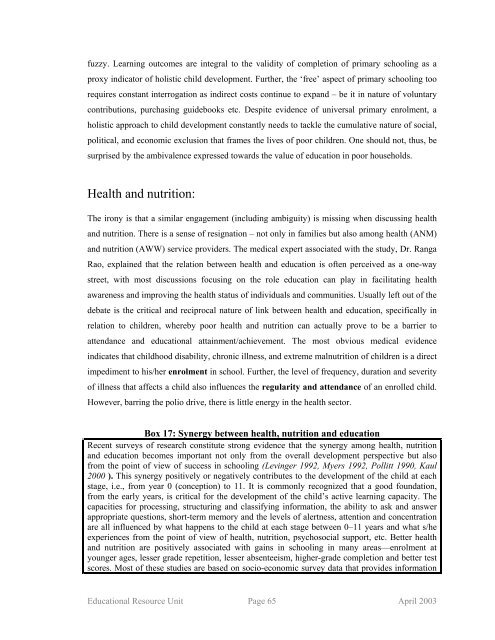Snakes and Ladders - ERU Consultants Pvt. Ltd.
Snakes and Ladders - ERU Consultants Pvt. Ltd.
Snakes and Ladders - ERU Consultants Pvt. Ltd.
Create successful ePaper yourself
Turn your PDF publications into a flip-book with our unique Google optimized e-Paper software.
fuzzy. Learning outcomes are integral to the validity of completion of primary schooling as a<br />
proxy indicator of holistic child development. Further, the ‘free’ aspect of primary schooling too<br />
requires constant interrogation as indirect costs continue to exp<strong>and</strong> – be it in nature of voluntary<br />
contributions, purchasing guidebooks etc. Despite evidence of universal primary enrolment, a<br />
holistic approach to child development constantly needs to tackle the cumulative nature of social,<br />
political, <strong>and</strong> economic exclusion that frames the lives of poor children. One should not, thus, be<br />
surprised by the ambivalence expressed towards the value of education in poor households.<br />
Health <strong>and</strong> nutrition:<br />
The irony is that a similar engagement (including ambiguity) is missing when discussing health<br />
<strong>and</strong> nutrition. There is a sense of resignation – not only in families but also among health (ANM)<br />
<strong>and</strong> nutrition (AWW) service providers. The medical expert associated with the study, Dr. Ranga<br />
Rao, explained that the relation between health <strong>and</strong> education is often perceived as a one-way<br />
street, with most discussions focusing on the role education can play in facilitating health<br />
awareness <strong>and</strong> improving the health status of individuals <strong>and</strong> communities. Usually left out of the<br />
debate is the critical <strong>and</strong> reciprocal nature of link between health <strong>and</strong> education, specifically in<br />
relation to children, whereby poor health <strong>and</strong> nutrition can actually prove to be a barrier to<br />
attendance <strong>and</strong> educational attainment/achievement. The most obvious medical evidence<br />
indicates that childhood disability, chronic illness, <strong>and</strong> extreme malnutrition of children is a direct<br />
impediment to his/her enrolment in school. Further, the level of frequency, duration <strong>and</strong> severity<br />
of illness that affects a child also influences the regularity <strong>and</strong> attendance of an enrolled child.<br />
However, barring the polio drive, there is little energy in the health sector.<br />
Box 17: Synergy between health, nutrition <strong>and</strong> education<br />
Recent surveys of research constitute strong evidence that the synergy among health, nutrition<br />
<strong>and</strong> education becomes important not only from the overall development perspective but also<br />
from the point of view of success in schooling (Levinger 1992, Myers 1992, Pollitt 1990, Kaul<br />
2000 ). This synergy positively or negatively contributes to the development of the child at each<br />
stage, i.e., from year 0 (conception) to 11. It is commonly recognized that a good foundation,<br />
from the early years, is critical for the development of the child’s active learning capacity. The<br />
capacities for processing, structuring <strong>and</strong> classifying information, the ability to ask <strong>and</strong> answer<br />
appropriate questions, short-term memory <strong>and</strong> the levels of alertness, attention <strong>and</strong> concentration<br />
are all influenced by what happens to the child at each stage between 0–11 years <strong>and</strong> what s/he<br />
experiences from the point of view of health, nutrition, psychosocial support, etc. Better health<br />
<strong>and</strong> nutrition are positively associated with gains in schooling in many areas—enrolment at<br />
younger ages, lesser grade repetition, lesser absenteeism, higher-grade completion <strong>and</strong> better test<br />
scores. Most of these studies are based on socio-economic survey data that provides information<br />
Educational Resource Unit Page 65 April 2003












